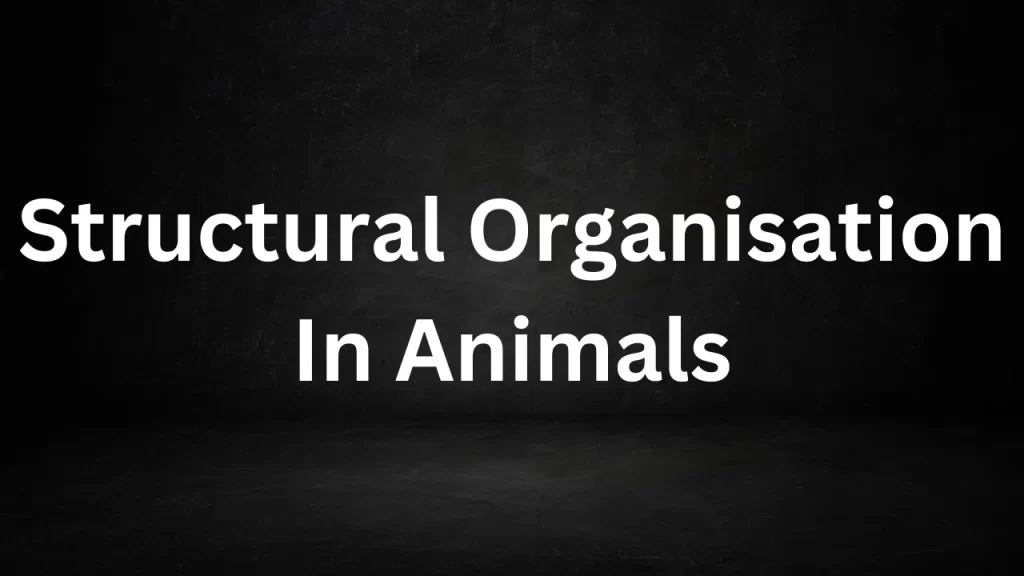Tag: neet structural organisation in animals syllabus
Structural Organisation In Animals
Structural Organisation In Animals: The structural organization in animals refers to the hierarchical arrangement of cells, tissues, organs, and organ systems that allows them to carry out various functions necessary for life.
This intricate organization is a hallmark of the animal kingdom and is essential for the survival, growth, and adaptation of different species.

Structural Organisation In Animals
1. Cells:
- The basic structural and functional unit of all living organisms is the cell.
- Animal cells are highly specialized and vary in shape and function based on the specific role they play in the body.
- Different types of cells include muscle cells, nerve cells (neurons), epithelial cells, and blood cells.
2. Tissues:
- Tissues are groups of similar cells that work together to perform a specific function.
- Four primary types of animal tissues are epithelial tissue (covering and lining), connective tissue (support and protection), muscle tissue (movement), and nervous tissue (communication and control).
3. Organs:
- Organs are composed of multiple tissues and have a more complex structure and specialized function.
- Examples of organs include the heart, lungs, liver, and brain.
- Organs often work together in organ systems to perform vital functions.
4. Organ Systems:
- Organ systems are groups of organs that collaborate to perform essential life processes.
- In humans, there are several organ systems, including the circulatory system, respiratory system, digestive system, nervous system, and skeletal system, among others.
- Each organ system has a specific function, and they often interact to maintain homeostasis, the body’s internal balance.
5. Body Cavities:
- Body cavities provide spaces for organs within the body and help protect them.
- In vertebrates, such as humans, the two main body cavities are the ventral (front) and dorsal (back) cavities.
- These cavities house and protect various organs, including the brain and spinal cord in the dorsal cavity and the heart, lungs, and digestive organs in the ventral cavity.
6. Symmetry and Complexity:
- Animals exhibit different degrees of symmetry, ranging from radial symmetry (seen in animals like jellyfish) to bilateral symmetry (seen in most vertebrates).
- The level of structural complexity also varies among animals, with simpler organisms having fewer specialized cells, tissues, and organs, while more complex organisms have a greater degree of specialization.
7. Adaptations and Evolution:
- Structural organization in animals is closely linked to their adaptations and evolution.
- Over time, species have developed specialized structures and systems that enable them to thrive in their specific environments.
- Evolutionary processes have led to the diversity of animal forms and functions seen in the natural world.
Read More
Frequently Asked Question (FAQs) Structural Organisation In Animals
What is structural organization in animals, and why is it important?
Structural organization in animals refers to the hierarchical arrangement of cells, tissues, organs, and organ systems that allows them to carry out various functions necessary for life. It is important because it enables animals to perform essential life processes, adapt to their environments, and exhibit a wide range of forms and complexities.
What are the four primary types of animal tissues, and what are their functions?
The four primary types of animal tissues are:
- Epithelial Tissue: It covers and lines body surfaces and cavities, protecting underlying tissues and facilitating absorption and secretion.
- Connective Tissue: It provides support, protection, and structure to various body parts and includes tissues like bone, cartilage, and blood.
- Muscle Tissue: Responsible for movement, muscle tissue includes skeletal, smooth, and cardiac muscles.
- Nervous Tissue: Enables communication and control within the body, comprising neurons and supporting cells.
What is the role of organs in the structural organization of animals?
Organs are composed of multiple tissues and have more complex structures and specialized functions. They play a critical role in the body by performing specific tasks necessary for survival, growth, and adaptation.
Can you provide examples of animal organ systems and their functions?
Certainly. Examples of animal organ systems include:
- Circulatory System: Responsible for transporting blood, oxygen, and nutrients throughout the body.
- Respiratory System: Facilitates the exchange of oxygen and carbon dioxide in the lungs.
- Digestive System: Breaks down and absorbs nutrients from food.
- Nervous System: Coordinates communication and control through the brain and nervous tissue.
- Skeletal System: Provides support, protection, and facilitates movement through bones and joints.
What is the significance of body cavities in structural organization?
Body cavities provide space for organs within the body and offer protection to these vital structures. In vertebrates, they help house and safeguard organs like the brain and heart, contributing to overall structural organization.